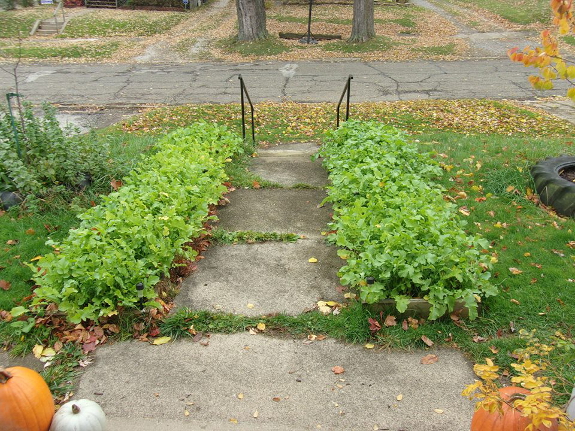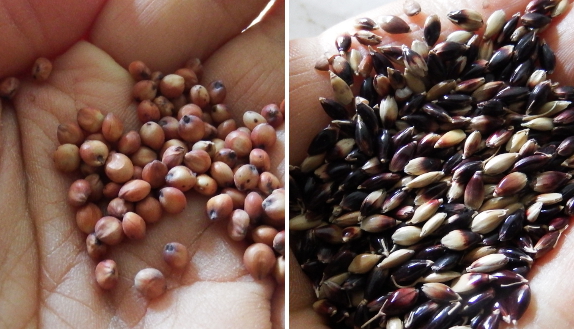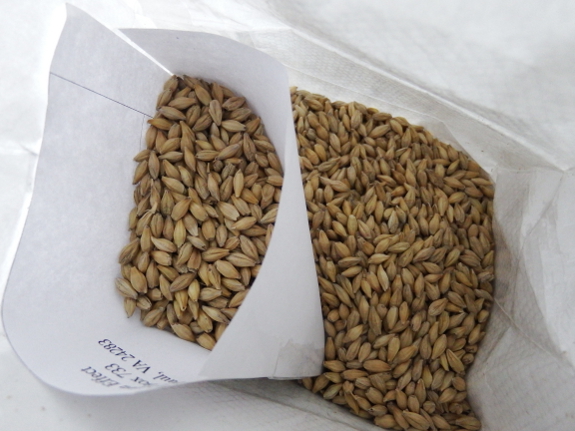
More new cover crops to try

Last fall, I sent out seeds of some of my tried-and-true
(along with a few experimental) cover crops to readers to see how the
species fared in other soils and climates. My favorite result is shown
above --- Aimee in Ohio planted oilseed radishes in beds that will be
used to grow strawberries this year. She reported: "[The oilseed
radishes] stayed crisp and green clear past Thanksgiving, which gave me a
ready supply of greens and radishes for the guinea pigs. I'll admit it,
I ate a few myself. Even though I am not a radish person, they weren't
bad." Oilseed radishes also got good reviews from Missouri, although
Charity in the Pacific Northwest preferred barley and white mustard in
her garden.

What's coming up this
spring? I splurged on several new varieties, which I plan to try out
both within the garden and as cut-and-come-again mulch producers in the
newly bare aisle soils in areas where I recently mounded up earth to
create higher raised beds. I figured --- why let that bare ground turn
into weedy lawn if it can do double-duty by producing biomass for the
garden instead? (Of course, I may regret this choice when I have to wade
through tall grasses to get to my tomato plants.)
New species on the planting agenda include:
- Barley --- This may be the plant I've been looking for to fill the
early-spring gap before weather warms enough to plant buckwheat. This
grain is supposed to mature enough to flower and be mow-killed in just a
little over two months. I wasn't terribly impressed when I tried barley
as a fall cover crop in the past, but I have higher hopes for its
performance in the spring garden.
- Sorghum-sudangrass hybrids --- I'm trying two different varieties, which look very distinctive in the seed stage (pictured above). I figure this will be a good fit for my aisle experiment.
- Pearl Millet --- This species should fill a niche similar to the sorghum-sudangrass.
- Alfalfa --- In part, I'm growing this legume for the goats since I'm currently buying alfalfa pellets to boost our milking doe's protein intake and calcium levels. But I figured it would also be interesting to see how alfalfa fares as a nitrogen-fixing cover crop left in place for the entire summer.

Want to join in the fun? I
have room for a few more experimenters since some of last fall's
gardeners dropped out. If you live in zones 3, 4, or 8, drop me an email
at anna@kitenet.net and we'll
chat. Folks chosen will receive free seeds as long as you promise to
share photos for my book and to report on your results!
Want more in-depth information? Browse through our books.
Or explore more posts by date or by subject.
About us: Anna Hess and Mark Hamilton spent over a decade living self-sufficiently in the mountains of Virginia before moving north to start over from scratch in the foothills of Ohio. They've experimented with permaculture, no-till gardening, trailersteading, home-based microbusinesses and much more, writing about their adventures in both blogs and books.
Want to be notified when new comments are posted on this page? Click on the RSS button after you add a comment to subscribe to the comment feed, or simply check the box beside "email replies to me" while writing your comment.

Nita --- Good reminder! Which might make the pearl millet a better all-around cover crop for a farm with livestock, even though I believe the sorghum-sudangrass produces more biomass.
Terry --- I'm looking for a cover crop that will do well in really poor soil while making lots of organic matter, which is where I think the sorghum-sudangrass might thrive. Oats have been the best in that regard in the past, but even they won't do much if your soil is really abysmal.